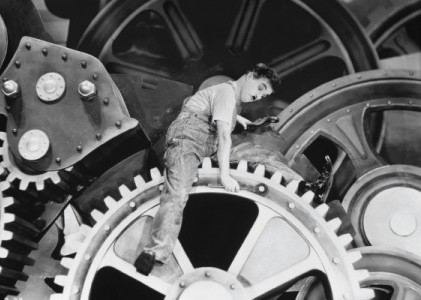Dumb Insolence
"You must speak!"
"I can't!"
"You must!"
(From The Great Dictator)
1927! Great honking blasts of raw sound come rasping through the previously silent cinema screen, threatening everything that has gone before. Charles Chaplin denounces the new medium: "They are defeating the meaning of the screen."
Three Chaplin films, City Lights (1931), Modern Times (1936) and The Great Dictator (1940), could be seen as retrenchments in the face of the relentless advance of talking pictures. City Lights is a wordless comedy which uses synchronized music (by Chaplin himself), a brief parody of the squawking voices of early Vitaphone recording, and the occasional sound-related gag as when Chaplin swallows a whistle and acquires a musical hiccup. These modest audio elements show that Chaplin, while sincerely detesting the talkies, was willing to embrace the possibilities of sound.
By the time he made The Great Dictator, Chaplin had yielded to the inevitable, but still sought to carve out pieces of the film which were purely wordless, like the dictator's dance with a globe of the world, or a breathtaking musical shaving routine. But Chaplin, in both his dual roles, spoke, and climaxed the film with an impassioned speech to camera in which he steps completely out of character and talks to the world. The last line of the film is "Listen!"
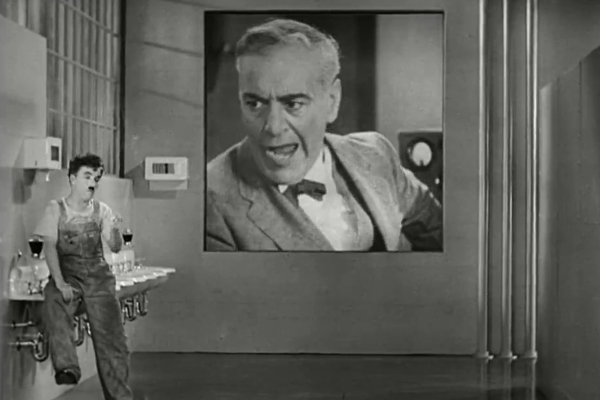
Modern Times
So Modern Times occupies a central and unique place: Chaplin is using the technology of the talking picture to make a sound picture that mostly refuses to talk. This defiant mutism is what's mainly been commented upon in the seventy-four years since the film appeared, along with its attack on modernity and the image of Chaplin against the machine. But both aspects are more complex than at first appears.
For its first few minutes, music and sound are used to amplify visual effects: the assembly line where Chaplin's anonymous worker tightens nuts on a conveyer belt, a mechanized man who can express his humanity only in his inefficiency, is given a more intense rhythm by Chaplin's score. Chaplin's score seems to stand in for the voice of the machine.
But when the hero is allowed a break, visits the lavatory, and attempts to smoke a cigarette, his boss appears on a huge wall-screen and berates him, using audible speech. Chaplin, undercranked at 20fps, is oppressed by a big talking head: the very image of the silent comedian threatened by the talkies. The clash of styles is pretty exciting, too. Since, for most of the film Chaplin confines speech to machinery such as this two-way TV (anticipating Orwell's 1984), a phonograph (a salesman has been so automated that he's reduced to a disembodied voice from a disc) and the radio, we have a sense of a world in which machinery has stolen the human voice. People are forced to communicate via intertitles. Or else the voice is the invention of machinery (the talking picture), and it is up for humanity (personified by Chaplin onscreen and off) to seize control of this new medium.
By shooting at silent movie speed, Chaplin retained the grace of his earlier films, but this meant that sound effects had to be added later. The stylised effect which resulted is no doubt influenced by Chaplin's music hall experience: rather than using authentic sounds, he uses slightly exaggerated or distorted ones. It's worth recalling that the term "slapstick" originally described a sound effects device designed to add impact to mock blows exchanged upon the stage: live dubbing. Maybe there's no Jacques Tati without Chaplin's use of sound here, and maybe there's no Fellini without his use of music, alternately smoothing over or pointing up the bold shifts in tone from comedy to pathos to melodrama.
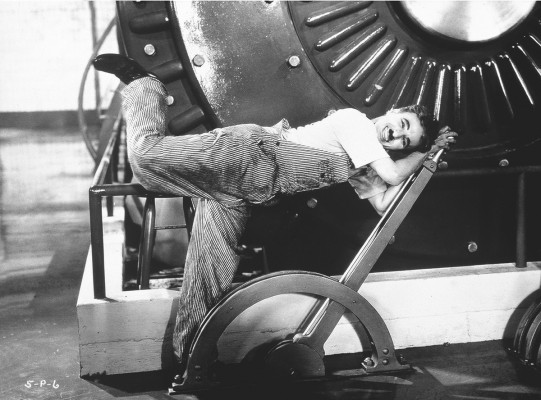
Modern Times
These emotional switchbacks are all the more striking because Modern Times largely eschews the unifying, goal-based structures of Chaplin's other features. With no central journey to hold it together, the set-piece scenes (what Harold Lloyd called "islands") feel more scattered, and the mood swings more startling. A rambling storyline can be held together by tonal consistency, but Chaplin needed to alternate comedy and tragedy: more than his unique selling point, this was the form he had developed and made his own. Some find the picaresque plot problematic: they had best avoid O Lucky Man! and La Dolce Vita.
"A particularly simple and transparent case" was Freud's verdict on Chaplin, concluding that the comedian always played an impoverished underdog because he couldn't escape the powerful impressions of his Dickensian youth in London's East End. Like the hero of He Who Gets Slapped (1924), he makes comedy from the unforgettable humiliation which obsesses him. Chaplin's first success was achieved with a drunk act in Fred Karno's comedy troupe. While Chaplin was never an alcoholic, his father died from drink. The tramp character owes its origins to Chaplin's personal experience of hunger and poverty. The closer Chaplin got to his own pain, the more popular he became. Even small, traumatic incidents from life could find themselves inflated in the movies. As a child, Chaplin nearly choked to death on a penny while trying to copy his elder brother's magic trick. The whistle-swallowing in City Lights is one echo of this, the force-feeding of metal nuts to the hero in Modern Times by a diabolical lunch-serving contraption is another, and in The Great Dictator Charlie is compelled to gulp down a whole pocketful of pennies. Even The Gold Rush features a moment where "the little fellow" licks clean a nail. That metallic taste must have formed a powerful sense memory in the young Chaplin.
At any rate, after alcoholism and poverty, in Modern Times Chaplin, for the first time, really starts to face, and comically exploit, the third phantom haunting him: his mother's mental illness.
Chaplin was high-strung, and his brother and business manager Sydney lived in daily expectation that Charlie would crack up for good (and enable Syd to convert the studio into a supermarket, as was his dream). He never quite did.
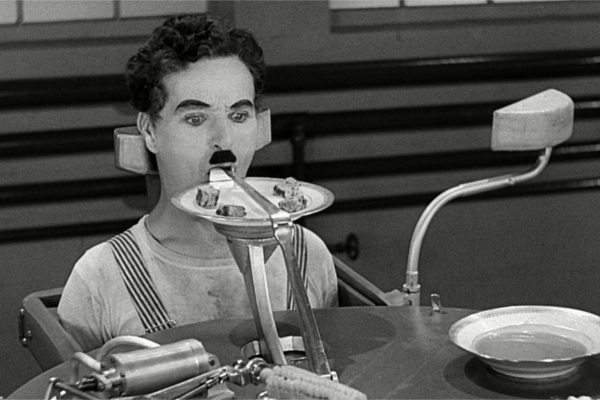
Modern Times
In Modern Times, Chaplin begins the film as a cog in a machine, something his character had never been before. Of course, he's an unsuccessful cog, and his fellow workers bear the brunt of his inefficiency. Whatever Chaplin's leftwing leanings, it's clear that his comic persona is fiercely individualistic and anarchic, not part of the mob, and he displays no sympathy as filmmaker to the other victims of the system, who are comic stooges persecuted as much by Charlie as by Capital.
The character's nervous breakdown frees him from the slightest desire to be a smoothly functioning part of the assembly line, while also perversely turning his job, nut-tightener, into an all-consuming obsession. First, he seizes upon one particular pair of nuts and tightens them beyond all reason. Then he plunges into the heart of the metal Moloch, tightening the very nuts of the capitalist. Emerging, he has been transformed into a bestial, nut-tightening god.
The old line that if you have a hammer, every problem begins to look like a nail is here transformed and incarnated. Charlie's whole world is made of nuts. As Walter Kerr says in his great book The Silent Clowns, comparing Chaplin to Pan is generally too easy and somewhat misleading, but in this case it really does fit. He's a satyr, and the sexual component of the tramp's character, which had been subdued since the early roughhouse shorts, is let loose: two women appear wearing hexagonal buttons on their bodies and the nut-fixated nut has them in his sights. Confronting a slender secretary with these tempting adornments on her skirt, he holds his spanners to his head: now they are floppy spaniel ears, but in a moment they spring erect and become proud horns.
When the pursuing lunatic Charlie is distracted from the peroxide beauty by an even more attractive fire hydrant, we appear to have crossed over into a bizarre world beyond perversity, perhaps next door to the biomechanical intermingling of Shinya Tsukamoto's Tetsuo films. Charlie has internalized the factory, and the great engines of industry, now incarnated in human flesh and blood, discover lust: the biomechanical passion of H.R. Giger or J.G. Ballard, which makes no distinction between flesh and metal. Only the arrival of a fat lady with nutty buttons on her ample bosom can restore slapstick (dis)order.
If the mechanical feeder Charlie has been strapped into reminds us of A Clockwork Orange (1971) and Malcolm McDowell bound to a chair, eyes pinned open to passively receive a filmshow, Modern Times also invokes that title in its intermingling of the biological with the mechanical: an organic thing behaving like a machine. The disturbingly realistic internal trickling and gurglings of indigestion are evoked in one scene, more evocative and convincing than anything heard in a film since: did Chaplin press a microphone to his own unruly guts? The effect is the excuse for some social discomfort comedy with a prison chaplain's wife, with both characters trying hard to pretend the sounds aren't there: making believe they're in a silent film. And then a voice intrudes, a radio commercial for an indigestion remedy. Charlie hastily switches the wireless off.
Man versus machine is usually taken as the theme of the film, so Chaplin's biological nature is worth insisting on in this manner: he's prone to drugs, alcohol, fatigue, nervous strain and heartburn. But the opposing force of mechanisation is not exclusively outside or separate from Chaplin's body. Just as Charlie can dive down the conveyor belt into the monster's gullet, so it can enter and possess him. Chaplin's comedy always embraced repetition as part of its choreography ("The son-of-a-bitch is a ballet dancer," said W.C. Fields), and here the looped behaviour comes to seem robotic. Henri Bergson would approve Chaplin's milking laughter from the reduction of humanity to mechanical stimulus-response.
Modern times will make you crazy: this theme is developed further in sequences where Charlie gets coked up and drunk, both times involuntarily. How Chaplin got the "nose-candy" past the censors is a mystery: the drugs references casually dropped in pre-coders had generally been stamped out by now. The effect of the stimulant is even more dehumanizing than the factory-induced breakdown: Chaplin starts mindlessly repeating actions, and escapes from his cell just by making one about-turn too many and marching off in the wrong direction. Like a faulty apparatus, he performs the right, pre-programmed moves at the wrong time.
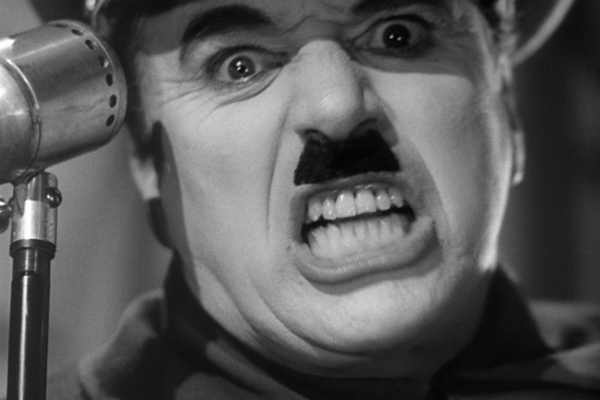
The Great Dictator
Derangement of the senses seems to be something Chaplin wanted to explore here, but the tramp's personality, once so hedonistic in the early days, has mellowed to the point where he has to be tricked by fate into getting wasted. The alcohol, forced on him at gunpoint, occurs during a scene of running amok in a department store, where he and the gamine (Paulette Goddard) are only interested in cake and toys, and beds (but just for sleeping). The once-lusty little fellow becomes more like a child as he ages.
This infantile side raises questions when it comes to the sort-of romance with Goddard, since she's explicitly positioned as, basically, a child, and yet is also one of Chaplin's sexiest co-stars and was his real-life partner. Her introduction, stealing and eating a banana, seems near the knuckle considering that Chaplin's fondness for oral sex had been cited in divorce proceedings, and his love of young teenage girls was well-known and much frowned upon. He compensates by underplaying the romance until it's hardly there at all, and one wonders exactly what the relationship is. When the tramp fantasizes a bucolic bourgeois home life with his gamine, the man-woman dynamic is fairly clear, but thoroughly domesticated. The real-life equivalent of this daydream, where she sends him off to work from their ramshackle shack with a jaw-breaking doorstop sandwich, feels like kids playing at being grown-ups. Certainly the rampant, aberrant sexuality of the mad scene has been wholly set aside in dealings with the leading lady.
After the movie has successfully driven Chaplin out of his mind (The Great Dictator would allow him another chance to explore insanity), it seems a shame that we're deprived of the chance to see how he's cured. The movie adopts the simple faith in psychiatry common at the time, and our hero emerges from hospital apparently functional once more. But he's no longer part of society. Through the rest of the film's deliberately meandering, picaresque plot, he will try his hand at just about everything, seeking to find a place in the modern world where someone like him (ie a human being) might belong. As the archetypal walk off into the sunset demonstrates, this is a process which can't reach a conclusion: like an out-of-control conveyor belt, it just carries on.
![]()
LATEST ARTICLES
-20140814-173707-thumb3.jpg)
Fighting Words
by Imogen Sara Smith
posted August 12, 2014

Fighting Words, Part 2
by Imogen Sara Smith
posted August 20, 2014

On the Margins: The Fil…
by Andrew Chan
posted August 12, 2014

Robin Williams: A Sense…
by David Schwartz
posted August 12, 2014
 Dumb Insolence
Dumb Insolence
THE AUTHOR
David Cairns is a writer, director, and blogger. His short film Cry For Bobo (2001) has won 24 awards around the world. He has written for several UK TV series including Intergalactic Kitchen and Twisted Tales. His articles have appeared in The Village Voice, The Believer, and Senses of Cinema.
More articles by David CairnsAuthor's Website: Shadowplay

